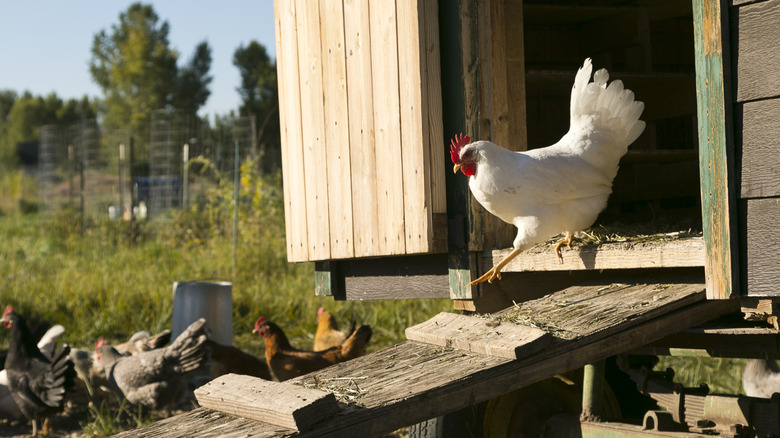The Clever Hack That Keeps Chickens Out Of Your Garden
We may receive a commission on purchases made from links.
Poultry is not just the purview of huge factory farms; keeping chickens at home can have huge benefits for your life beyond fresh eggs. However, many who keep backyard chickens will likely be planting flowers or growing vegetables in their garden nearby. Chickens can bolster yard revitalization projects by eating pests, aerating the dirt when they dig, tearing up weeds, and leaving natural fertilizer. There are best practices to keep your family safe with backyard chickens, such as using dedicated yard-working boots or not holding the poultry near your face. Similarly, you can take steps to stop them from digging up your personal garden, which is where building a chicken tunnel (sometimes called a "chunnel") comes in handy.
The idea behind this home garden hack is simple. Most chicken-keeping infrastructure includes an enclosed run, or an area fenced off by a large cage that lets the livestock roam freely in open air. These runs protect the poultry from predators or diseased wild birds, while also giving them room to exercise and mingle in innate ways that will make them happier and healthier — improving the quality of their eggs and meat in the process. Chicken tunnels are essentially short runs that can bridge longer spaces between different points of interest, ensuring your birds can roam from place to place without digging up the freshly planted seeds in your yard. A chicken tunnel can also keep them away from plants that could be dangerous for them to consume, including tomatoes, peppers, potatoes, eggplant, rhubarb, dried beans, and onions.
How to build a chicken tunnel in your yard
Given that a chicken tunnel is generally a smaller version of the run that you've likely built for your backyard coop, most of the materials required may already be on-hand. Bent PVC pipes that frame stretches of chicken wire or non-rusting metals are the basic components, as seen in this video by TikTok user @jerrasgarden, with something like zip ties or duct tape to hold the individual chunks of netting together. You should bury the edges of the tunnel frame into your yard's soil, and heavier garden wall-building materials such as bricks can be used to weigh down the corners of this lighter frame while maintaining its basic shape. Most chickens are less than 30 inches tall on average, so keep that in mind when sizing your chicken tunnel.
When planning a chicken tunnel, you could consider having one stretch of wire sit a few inches above the ground to slip them extra food or entertainment. Chunnels are incredibly versatile; they can bend and curve to whatever shape to best avoid beloved plants in your garden. You can even branch out your chicken tunnel in multiple directions, so long as you have the essential gardening tools and ties to cut open new holes and attach extensions of wire. Raising backyard chickens has been a regular feature of urban life since the first World War encouraged food rationing, and building your own chicken tunnel is one fun way to keep up that tradition while you keep your livestock safe. And if you really don't want to build one yourself, you can always buy one that's already put together.
